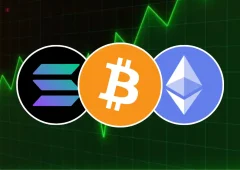Investor Reaps 1,900,000% Profit After Holding This Altcoin for Two Years
14.12.2024 16:00 1 min. read Alexander Zdravkov
The cryptocurrency market saw a resurgence in activity after Donald Trump’s U.S. election victory, with previously inactive accounts springing back to life to seize opportunities in the bullish rally.
Among these, a PEPE token investor managed to achieve extraordinary returns, transforming a mere $27 into an eye-popping $52 million after holding trillions of tokens for over two years.
This investor, now dubbed a dormant PEPE whale, was inactive for nearly 600 days before returning to the market. According to Lookonchain, the whale initially spent just 0.0135 ETH—worth $27 at the time—to purchase 2.1 trillion PEPE tokens at rock-bottom prices. Fast forward to today, the explosive growth of the token has resulted in a 1,900,000x return. Rather than cashing out, the whale opted to move the tokens into a new wallet, leaving their investment untouched.
Remarkably, this isn’t the only tale of life-changing profits from PEPE tokens. Another trader reportedly turned $70 into $7 million by holding the asset for the same two-year period. These stories exemplify the potential of meme coins to generate massive returns, even from the smallest investments.
However, such success comes with significant risks. Meme-themed cryptocurrencies are notorious for their volatility, and while they can deliver jaw-dropping gains, they can also result in substantial losses. Navigating this market requires careful planning and strategic trading decisions to mitigate the inherent risks.
-
1
This Week in Crypto: Whale Accumulation, Ethereum Signals, and a Sentiment Shake-Up
05.07.2025 21:00 3 min. read -
2
Pepe Price Prediction: One-Month Trend Line Resistance Breakout Could Push PEPE to $0.000015
04.07.2025 18:41 3 min. read -
3
Bonk Price Prediction: Binance.US Mention Triggers 9% Jump – Can BONK Reach $1?
07.07.2025 16:29 3 min. read -
4
Top 10 Trending Cryptocurrencies Today, According to CoinGecko
04.07.2025 15:31 3 min. read -
5
How Much Profit Would you Make if you Invested $3,000 in Shiba Inu One Year Ago?
09.07.2025 22:00 2 min. read
Crypto’s Top Narratives in Focus, According to AI
A fresh breakdown from CoinMarketCap’s AI-powered narrative tracker reveals the four most influential crypto trends currently shaping the market: BTCFi & DePIN, U.S. regulatory breakthroughs, AI agent economies, and real-world asset (RWA) tokenization.
Top Trending Cryptos Right Now, According to CoinMarketCap
CoinMarketCap’s evolving momentum algorithm—powered by social, price, and news signals—has flagged three standout cryptocurrencies driving narrative and capital flows this week: OKZOO, Tagger, and Tezos.
Top 7 Crypto Project Updates This Week
The crypto industry saw major advancements this past week across DeFi, NFT, Layer 2, and AI-powered platforms.
U.S. Ethereum ETFs See $402 Million Net Inflow Led by BlackRock’s ETHA
On July 18, Ethereum ETFs in the U.S. recorded a combined net inflow of $402.5 million, signaling strong institutional demand even as some funds saw outflows.
-
1
This Week in Crypto: Whale Accumulation, Ethereum Signals, and a Sentiment Shake-Up
05.07.2025 21:00 3 min. read -
2
Pepe Price Prediction: One-Month Trend Line Resistance Breakout Could Push PEPE to $0.000015
04.07.2025 18:41 3 min. read -
3
Bonk Price Prediction: Binance.US Mention Triggers 9% Jump – Can BONK Reach $1?
07.07.2025 16:29 3 min. read -
4
Top 10 Trending Cryptocurrencies Today, According to CoinGecko
04.07.2025 15:31 3 min. read -
5
How Much Profit Would you Make if you Invested $3,000 in Shiba Inu One Year Ago?
09.07.2025 22:00 2 min. read


